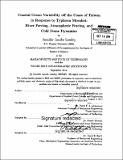| dc.contributor.advisor | Pierre F. J. Lermusiaux. | en_US |
| dc.contributor.author | Landry, Jennifer Jacobs | en_US |
| dc.contributor.other | Woods Hole Oceanographic Institution. | en_US |
| dc.coverage.spatial | a-ch--- | en_US |
| dc.date.accessioned | 2015-02-05T18:21:24Z | |
| dc.date.available | 2015-02-05T18:21:24Z | |
| dc.date.copyright | 2014 | en_US |
| dc.date.issued | 2014 | en_US |
| dc.identifier.uri | http://hdl.handle.net/1721.1/93792 | |
| dc.description | Thesis: S.M., Joint Program in Applied Ocean Science and Engineering (Massachusetts Institute of Technology, Department of Mechanical Engineering; and the Woods Hole Oceanographic Institution), 2014. | en_US |
| dc.description | Cataloged from PDF version of thesis. | en_US |
| dc.description | Includes bibliographical references (pages 79-81). | en_US |
| dc.description.abstract | The ocean is a complex, constantly changing, highly dynamical system. Prediction capabilities are constantly being improved in order to better understand and forecast ocean properties for applications in science, industry, and maritime interests. Our overarching goal is to better predict the ocean environment in regions of complex topography with a continental shelf, shelfbreak, canyons and steep slopes using the MIT Multidisciplinary Simulation, Estimation and Assimilation Systems (MSEAS) primitive-equation ocean model. We did this by focusing on the complex region surrounding Taiwan, and the period of time immediately following the passage of Typhoon Morakot. This area and period were studied extensively as part of the intense observation period during August - September 2009 of the joint U.S. - Taiwan program Quantifying, Predicting, and Exploiting Uncertainty Department Research Initiative (QPE DRI). Typhoon Morakot brought an unprecedented amount of rainfall within a very short time period and in this research, we model and study the effects of this rainfall on Taiwan's coastal oceans as a result of river discharge. We do this through the use of a river discharge model and a bulk river-ocean mixing model. We complete a sensitivity study of the primitive-equation ocean model simulations to the different parameters of these models. By varying the shape, size, and depth of the bulk mixing model footprint, and examining the resulting impacts on ocean salinity forecasts, we are able to determine an optimal combination of salinity relaxation factors for highest accuracy. | en_US |
| dc.description.statementofresponsibility | by Jennifer Jacobs Landry. | en_US |
| dc.format.extent | 81 pages | en_US |
| dc.language.iso | eng | en_US |
| dc.publisher | Massachusetts Institute of Technology | en_US |
| dc.rights | M.I.T. theses are protected by copyright. They may be viewed from this source for any purpose, but reproduction or distribution in any format is prohibited without written permission. See provided URL for inquiries about permission. | en_US |
| dc.rights.uri | http://dspace.mit.edu/handle/1721.1/7582 | en_US |
| dc.subject | Joint Program in Applied Ocean Science and Engineering. | en_US |
| dc.subject | Mechanical Engineering. | en_US |
| dc.subject | Woods Hole Oceanographic Institution. | en_US |
| dc.subject.lcsh | Ocean-atmosphere interaction | en_US |
| dc.subject.lcsh | Numerical weather forecasting | en_US |
| dc.title | Coastal ocean variability off the coast of Taiwan in response to typhoon Morakot : river forcing, atmospheric forcing, and cold dome dynamics | en_US |
| dc.type | Thesis | en_US |
| dc.description.degree | S.M. | en_US |
| dc.contributor.department | Joint Program in Applied Ocean Physics and Engineering | en_US |
| dc.contributor.department | Woods Hole Oceanographic Institution | en_US |
| dc.contributor.department | Massachusetts Institute of Technology. Department of Mechanical Engineering | |
| dc.identifier.oclc | 890937435 | en_US |
